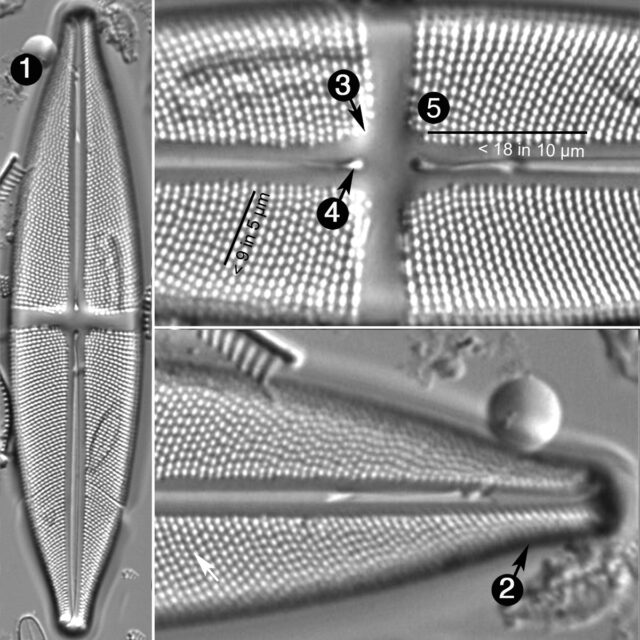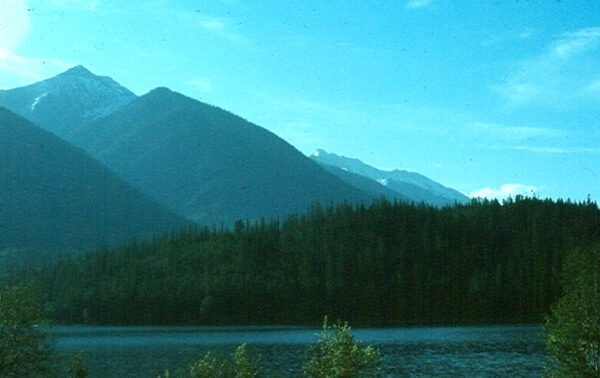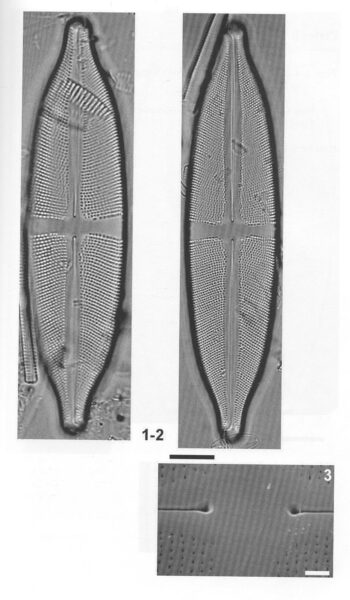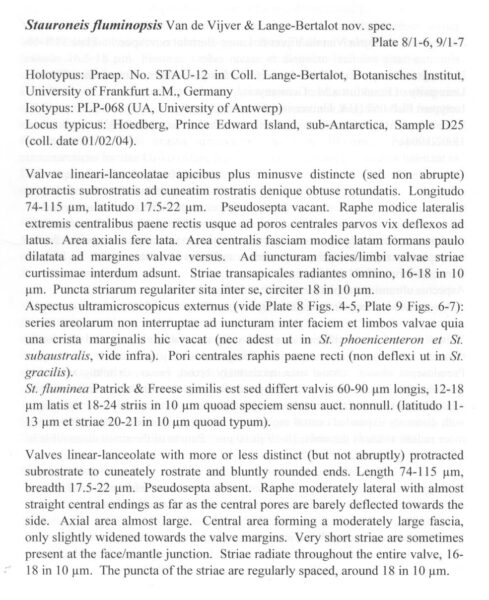Stauroneis fluminopsis
-
Category
-
Length Range76-101 µm
-
Width Range17-22 µm
-
Striae in 10 µm15-18
-
ContributorLoren Bahls - Dec 2011
-
ReviewerMarina Potapova - Mar 2012
Identification
Description
Valves are broadly linear-lanceolate with bluntly rounded subrostrate apices. The axial area is linear, two to three times wider than the raphe, and only slightly wider near the central area. The central area is a narrow, almost rectangular stauros, expanding slightly towards the valve margins. Short striae are sometimes present in the stauros at the valve margins. The raphe is lateral, becoming filiform at the ends. Terminal raphe fissures are hooked. Proximal raphe ends are nearly straight and slightly inflated. Striae are wavy and radiate throughout. Areolae are coarse and number 14-17 in 10 µm.
Autecology
Stauroneis fluminopsis was found in six lakes and wetlands in the Northern Rockies. The pH of these waters ranges from 6.0 to 8.6 and specific conductance ranges from 40 to 250 µS/cm. Van de Vijver et al. (2004) described this species from the Antarctic, where it was found in pools and small rivers with a pH of 6.0-7.5 and a specific conductance of 50-200 µS/cm.
-
Size Range, µm3
-
Motility
-
Attachment
-
Habitat
-
Colony
-
Waterbody
- Learn more about this
Original Description
Valves linear-lanceolate with more or less distinct (but not abruptly) protracted subrostrate to cuneately rostrate and bluntly rounded ends. Length 74-115 µm, breadth 17.5-22 µm. Pseudosepta absent. Raphe moderately lateral with almost straight central endings as far as the central pores are barely deflected towards the side. Axial area almost large. Central area forming a moderately large fascia, only slightly widened towards the valve margins. Very short striae are sometimes present at the face/mantle junction. Striae radiate throughout the entire valve, 16-18 in 10 µm. The puncta of the striae are regularly spaced, around 18 in 10 µm.
-
AuthorVan de Vijver and Lange-Bert. 2004
-
Length Range75-115 µm
-
Width17.5-22 µm
-
Striae in 10µm16-18
Citations & Links
Citations
Links
Cite This Page
Bahls, L. (2011). Stauroneis fluminopsis. In Diatoms of North America. Retrieved April 25, 2024, from https://diatoms.org/species/stauroneis_fluminopsis
Responses
The 15 response plots show an environmental variable (x axis) against the relative abundance (y axis) of Stauroneis fluminopsis from all the stream reaches where it was present. Note that the relative abundance scale is the same on each plot. Explanation of each environmental variable and units are as follows:
ELEVATION = stream reach elevation (meters)
STRAHLER = distribution plot of the Strahler Stream Order
SLOPE = stream reach gradient (degrees)
W1_HALL = an index that is a measure of streamside (riparian) human activity that ranges from 0 - 10, with a value of 0 indicating of minimal disturbance to a value of 10 indicating severe disturbance.
PHSTVL = pH measured in a sealed syringe sample (pH units)
log_COND = log concentration of specific conductivity (µS/cm)
log_PTL = log concentration of total phosphorus (µg/L)
log_NO3 = log concentration of nitrate (µeq/L)
log_DOC = log concentration of dissolved organic carbon (mg/L)
log_SIO2 = log concentration of silicon (mg/L)
log_NA = log concentration of sodium (µeq/L)
log_HCO3 = log concentration of the bicarbonate ion (µeq/L)
EMBED = percent of the stream substrate that is embedded by sand and fine sediment
log_TURBIDITY = log of turbidity, a measure of cloudiness of water, in nephelometric turbidity units (NTU).
DISTOT = an index of total human disturbance in the watershed that ranges from 1 - 100, with a value of 0 indicating of minimal disturbance to a value of 100 indicating severe disturbance.

Stauroneis fluminopsis
- Valves large, linear-lanceolate
- Apices subrostrate
- Stauros narrow, nearly rectangular
- Proximal raphe ends straight, weakly inflated
- Striae and areolae fewer than 19 in 10 µm
Valves are large linear-lanceolate with subrostrate apices. The stauros is narrow and nearly rectangular. Proximal raphe ends are straight and weakly inflated. Striae and areolae are fewer than 19 in 10 µm.
 Diatoms of North America
Diatoms of North America








